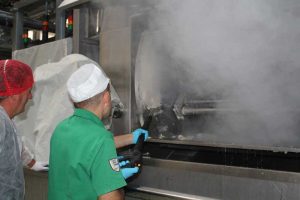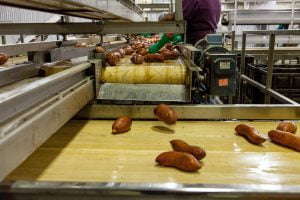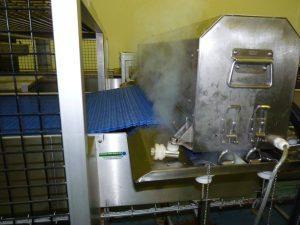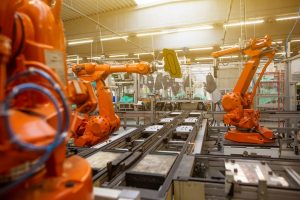A dirty conveyor belt system can pose potential risks and hazards in the food industry. Contaminants such as bacteria, mould, allergens, and foreign objects can accumulate on the surface of the conveyor belts, leading to cross-contamination and foodborne illnesses. These contaminants can also affect the taste, appearance, and shelf life of food products. Therefore, it is crucial for food manufacturers to prioritize regular cleaning and maintenance of their conveyor belt systems to prevent contamination and maintain food safety.
How Conveyor Belt Cleaning Improves Food Quality
A clean conveyor belt system plays a significant role in improving the overall quality of food products. When a conveyor belt is free from contaminants, it ensures that the food being transported remains uncontaminated throughout the production process. This helps to maintain the taste, appearance, and texture of the food products. Additionally, a clean conveyor belt system can also extend the shelf life of perishable items by preventing the growth of bacteria and mould. By investing in regular cleaning and maintenance of their conveyor belts, food manufacturers can ensure that their products meet high-quality standards.
The Benefits of Using Steam Vapour Cleaning Machines
Steam vapour cleaning machines are an effective method for cleaning conveyor belts in the food industry. These machines use high-temperature steam to sanitize and disinfect the conveyor belts, eliminating bacteria, mould, and other contaminants. The use of steam is a chemical-free and environmentally friendly cleaning method, making it ideal for the food industry. Steam vapour cleaning machines can also reach into hard-to-reach areas of the conveyor belt system, ensuring a thorough and deep clean. By using steam vapour cleaning machines, food manufacturers can maintain a clean and safe conveyor belt system without the use of harsh chemicals.
The Advantages of Automatic Conveyor Belt Steam Vacuum
| Benefit | Description |
|---|---|
| Chemical-free cleaning | Steam vapour cleaning machines use only water to clean, making them an eco-friendly and safe option for cleaning. |
| Effective disinfection | The high temperature of steam vapour can kill bacteria, viruses and other pathogens, making it an effective disinfectant. |
| Cost-effective | Using steam vapour cleaning machines can save money in the long run as they eliminate the need for expensive cleaning chemicals and reduce water usage. |
| Time-saving | Steam vapour cleaning machines can clean and disinfect surfaces quickly and efficiently, reducing cleaning time and increasing productivity. |
| Versatile | Steam vapour cleaning machines can be used on a variety of surfaces, including floors, walls, upholstery and carpets. |
Automatic conveyor belt steam vacuum systems are another effective method for cleaning conveyor belts in the food industry. These systems work by combining steam cleaning with vacuum suction to remove dirt, debris, and contaminants from the conveyor belts. The use of automatic systems increases efficiency and reduces labor costs as it eliminates the need for manual cleaning. Additionally, these systems can be programmed to clean at regular intervals, ensuring that the conveyor belts are consistently clean and free from contaminants. By using automatic conveyor belt steam vacuum systems, food manufacturers can streamline their cleaning processes and maintain a high level of cleanliness in their production facilities.
The Role of Conveyor Belt Cleaning in Food Safety
Conveyor belt cleaning plays a crucial role in maintaining food safety in the food industry. Failure to properly clean and sanitize conveyor belts can lead to cross-contamination and the spread of foodborne illnesses. Contaminants such as bacteria, mould, allergens, and foreign objects can easily transfer from one food product to another if the conveyor belts are not cleaned regularly. This can pose serious health risks to consumers and result in costly recalls for food manufacturers. Therefore, it is essential for food manufacturers to prioritize conveyor belt cleaning as part of their food safety protocols.
The Impact of Conveyor Belt Cleaning on Efficiency

A clean conveyor belt system can significantly improve overall efficiency in the food industry. When the conveyor belts are free from contaminants, there is a reduced risk of product recalls and production downtime due to contamination issues. This leads to increased productivity and cost savings for food manufacturers. Additionally, a clean conveyor belt system allows for smoother and faster product flow, reducing the chances of bottlenecks and delays in the production process. By investing in regular cleaning and maintenance of their conveyor belts, food manufacturers can optimize their operations and improve overall efficiency.
The Different Types of Conveyor Belt Cleaning Methods
There are several different cleaning methods available for conveyor belts in the food industry. These include manual cleaning, chemical cleaning, steam cleaning, and automatic cleaning systems. Each method has its pros and cons, and food manufacturers should choose the method that best suits their specific needs and requirements. Manual cleaning involves physically scrubbing the conveyor belts with brushes or sponges, which can be time-consuming and labor-intensive. Chemical cleaning involves the use of cleaning agents to remove contaminants from the conveyor belts, but it may leave behind chemical residues that can affect food safety. Steam cleaning and automatic cleaning systems offer more efficient and effective methods for conveyor belt cleaning, as discussed earlier.
The Future of Conveyor Belt Cleaning Technology
The future of conveyor belt cleaning technology is promising, with emerging technologies and innovations being developed to improve efficiency and effectiveness. One such innovation is the use of ultraviolet (UV) light technology to disinfect conveyor belts. UV light has been proven to kill bacteria, viruses, and mould spores, making it an ideal method for conveyor belt cleaning in the food industry. Another emerging technology is the use of robotics for automated conveyor belt cleaning. Robotic systems can be programmed to clean conveyor belts at regular intervals, reducing the need for manual labor and increasing efficiency. These advancements in conveyor belt cleaning technology have the potential to revolutionize the food industry by ensuring higher levels of cleanliness and food safety.
The Need for Effective Conveyor Belt Cleaning in the Food Industry
In conclusion, maintaining a clean conveyor belt system is of utmost importance in the food industry. A dirty conveyor belt system can pose potential risks and hazards, leading to contamination and compromised food safety. Regular cleaning and maintenance of conveyor belts not only prevent contamination but also improve the overall quality of food products. The use of steam vapour cleaning machines and automatic conveyor belt steam vacuum systems offer effective and efficient methods for cleaning conveyor belts. These methods sanitize and disinfect the conveyor belts, ensuring a high level of cleanliness and food safety. As technology continues to advance, the future of conveyor belt cleaning looks promising, with emerging technologies and innovations that will further enhance efficiency and effectiveness in the food industry.
FAQs
What is a conveyor belt?
A conveyor belt is a mechanical device used to transport materials from one location to another. It consists of a belt that rotates around two or more pulleys.
Why is conveyor belt cleaning important?
Conveyor belt cleaning is important to maintain food quality and production efficiency. If the conveyor belt is not cleaned properly, it can lead to contamination of food products and decrease the efficiency of the production process.
What are the different types of conveyor belt cleaning methods?
The different types of conveyor belt cleaning methods include dry cleaning, wet cleaning, and steam cleaning. Dry cleaning involves using brushes or scrapers to remove debris from the belt. Wet cleaning involves using water and cleaning agents to clean the belt. Steam cleaning involves using high-pressure steam to clean the belt.
What are the benefits of conveyor belt cleaning?
The benefits of conveyor belt cleaning include improved food quality, increased production efficiency, reduced downtime, and decreased risk of contamination.
What are the risks of not cleaning conveyor belts?
The risks of not cleaning conveyor belts include contamination of food products, decreased production efficiency, increased downtime, and potential legal and financial consequences.
How often should conveyor belts be cleaned?
Conveyor belts should be cleaned regularly, depending on the type of food being transported and the production environment. Generally, belts should be cleaned at least once a day, but some may require more frequent cleaning.
What are the best practices for conveyor belt cleaning?
The best practices for conveyor belt cleaning include using the appropriate cleaning method for the type of belt and food being transported, following manufacturer guidelines, using food-grade cleaning agents, and regularly inspecting and maintaining the belt.










